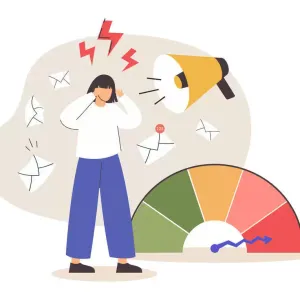

Our Review Process
Our articles undergo extensive medical review by board-certified practitioners to confirm that all factual inferences with respect to medical conditions, symptoms, treatments, and protocols are legitimate, canonical, and adhere to current guidelines and the latest discoveries. Read more.
Our Editorial Team
Shifa Fatima, MSc.
Author
Dr. Apoorva T, MHM.
MEDICAL ADVISOR
CGM VS Glucometer - Which One to Choose?
Imagine you are on a long and weary road trip, where you know the destination, but have lost the map containing directions to get there. For many individuals with diabetes, every day can be like this- tiresome, lonely and with seemingly no end in sight. The hack to getting back on track is through glucose monitoring. So if diabetes reversal is the destination you seek, Glycemic Monitoring is the Map that will take you there. Glycemic or Glucose self-monitoring can be done using two different devices - the Glucometer and the CGM device. Broadly speaking, both the Glucometer and CGM serve the same purpose, which is to measure your glycemic levels. But since their input parameters are different, the output values are also incomparable. In this article, we touch upon the differences between the two devices, why their values cannot be compared and how each of them make standalone contributions to your diabetes management. Also know about postprandial glucose
To learn more about the basics of Glucose monitoring devices, check out our Starter’s Guide on Glucometer and CGM.
Table of Contents
Why is it necessary to monitor Blood Glucose Levels?
Glucose monitoring is the main way that people with diabetes can manage their condition. By using glucose monitoring devices to check your blood glucose levels routinely, you’ll know when your blood sugar is too high or too low, both of which can cause serious health problems. Knowing your blood glucose levels also helps with decisions about what / how much to eat, how much to exercise, and whether any medication or visits to the doctor are required. The two most popular methods of measuring glycemic levels is through Self Monitoring of Blood Glucose (SMBG), using a Glucometer and Flash Glucose Monitoring using a CGM device. Know about diabetes treatment in pregnancy.
What is a Continuous Glucose Monitoring?
For people with diabetes, it is sometimes important to monitor blood sugar levels every few minutes. To carry this out, there is a special device known as a continuous glucose monitor which helps track the patient’s blood sugar levels every 5-15 minutes, as required. It helps to detect trends and patterns of your blood sugar levels which in turn will help your doctor to understand your condition exactly. It also gives data that can help manage your diabetes. Read more to know about what level of blood sugar is dangerous?
What are the uses of CGM?
A CGM or continuous glucose monitoring has a tiny sensor that's inserted under your skin. The sensor tests your blood sugar level every few minutes and sends the data to a location like a phone or a device which allows you to view it.
CGM is great for those with type 1 diabetes. The constant checks of blood sugar levels can be inconvenient when you have to keep pricking your fingers. CGM circumvents this problem and ensures you are up to date on your blood glucose levels. There has been much discussion on CGM vs glucometer topic, but the usage depends on the requirement. Also know about pp blood sugar

Who Should Use a CGM?
People with Type 1 diabetes need constant monitoring of blood glucose levels. CGM is extremely useful for that. At the same time it is essential to understand the pros and cons of cgm.
Pros -
- The sensor lasts for up to 90 days so you don’t need to replace it time and again.
- You can set alerts on the device and it can warn you when the levels are about to go up or go down.
- The results are easy to see and get recorded automatically.
Cons -
- The insertion of the sensor requires a small procedure at the doctor’s office that results in scar tissue.
- The transmitter adhesive backing should be replaced every 24 hours.
- The transmitter needs to be charged for about 10 minutes everyday. The battery can run up to 40 hours. Also know about blood sugar post prandial
What are the uses of glucometer?
In order to know the uses of glucometer, it is essential to understand what is a glucometer? It is a small and portable device that can be used to check your blood sugar levels at home. You get the results immediately and you can monitor your blood sugar levels without worrying about it dropping or spiking to dangerous levels.
Glucometer is used to check glucose levels in the blood of those with diabetes. Glucometer uses are important to monitor blood sugar levels and ensure your safety. Here are the uses for glucometer -
- Control your blood sugar levels by checking constantly.
- See how your blood sugar levels respond to exercise or stress.
- Find out what affects your blood sugar levels adversely and avoid those things actively.
- Monitor the effects of therapy and medications on your body.
- Map the effects of treatment and see if you are meeting goals
Who Should Use a Glucometer?
Glucometers should be used by the following people to measure their blood glucose levels.
You should use a glucometer if you have -
- Type 1 diabetes
- Type 2 diabetes
- Latent autoimmune diabetes in adults
- Gestational diabetes
What is the Difference Between a CGM and Glucometer
The two most commonly used devices for regular monitoring are a Glucometer and a CGM device which use the Fingerstick & Flash glucose monitoring methods respectively.
(a) Fingerstick Glucose Monitoring
This refers to the method used by a Glucometer, where the finger is pricked to obtain a drop of capillary blood to test its glucose levels. This method is useful for Self-monitoring of Blood Glucose (SMBG) by the user themselves.
(b) Flash Glucose Monitoring
This refers to the quick nature of CGM devices in measuring glucose levels. The CGM sensor measures your interstitial fluid, which is a thin layer of fluid that sits in between or surrounds the cells of the tissues below your skin. The term Flash is synonymous to the phrase “in a flash” alluding to the instantaneous values seen when the CGM sensor is scanned with a Reader.
What are the Key differences between SMBG and FGM?

Why don't the readings between a Glucometer and a CGM Sensor ever match?
To start with, the samples being utilized by both devices to measure blood sugar levels are not the same. A Glucometer measures the sugar levels in capillary blood, while the Flash Sensor readings come from the Interstitial Fluid (ISF). The CGM sensor measures your interstitial fluid, which has a 10-15 minute phase-shifted delay vs a finger prick blood reading. This difference in readings becomes even more pronounced when your glucose levels are experiencing a rise or a fall as opposed to being flat and steady. However, this does not affect their reliability in reflecting glucose levels. Know more about glucometer price.
Accuracy of CGM vs Glucometer
The most common metric used to assess performance and accuracy of a monitoring system is by looking at the Mean Absolute Relative Difference (MARD). MARD is the average of all absolute errors between the device (Glucometer or CGM) and the matched lab reference values. When compared against the lab reference values, both Glucometer and CGM have some margin of error. According to a 2014 study, a MARD between 10 - 12% is accurate enough to give us insights on the patterns of hypo and hyperglycemia events over time, to help in making decisions about carbohydrate intake, changes in medication/insulin dosage and to avoid such events in the future.
Accuracy of the Sugar.Fit CGM
The CGM Device provided by Sugar.Fit is factory calibrated and therefore does not require you the user to do it yourself. This is a good advantage that CGM has over a glucometer since testing of capillary blood glucose is more susceptible to various system and user errors. The Sugar.Fit CGM collects up to 14 days of glucose readings, which are recorded once every 15 minutes. The glucose sensor which is applied on your arm is fully disposable and the data can be recorded or obtained in two ways.
(a) Transfer the data from the sensor to an NFC enabled mobile phone
(b) Thrice a week visits by a representative , who will use a Reader to activate and scan the sensor to obtain data recorded thus far.
CGM Reports provide you with an assessment of glucose variability and hypoglycemia risk, along with daily patterns, daily glucose report, and an overall snapshot report. The overall MARD for the Sugar.Fit CGM is 11.4% and it utilizes glucose oxidase in a “direct signaling” approach. This means that the device is not dependent on oxygen thus minimizing any sort of interference that may be caused by other substances resulting in falsely elevated readings.
Note:
- It is important to note that sensor accuracy is lower on day 1 and may show values in a hypoglycemic range.
- However, this accuracy improves from Day 2 and remains steady over the remaining 14-day wear period.
- Due to the physiologic lag time between blood and interstitial glucose, you may see a vast difference in blood sugar values between your Glucometer and CGM readings. This may become even more magnified in the postprandial or post-meal period.
How do we obtain data from a Glucometer and CGM device?
Glucometers are small machines that work by analyzing a small amount of capillary blood from the fingertip. A lancet attached to the diabetes machine lightly pricks the skin to obtain the capillary blood which is then measured by the device, giving you the current reading of your blood sugar level. The CGM system has two components - a Sensor and a Reader, that work together to measure your sugar levels. It starts with the application of a minimally invasive electrochemical sensor below the skin on your upper arm and initiates a one-second painless scan. On initiation, the sensor emits a low frequency signal to communicate blood sugar data to a reader device and get data on your blood sugar patterns. You will then receive your current glucose reading, showing you the trend and the direction in which your glucose levels were headed in the last 8 hours. Also read about random blood sugar normal range
What are some of the benefits of using Flash Monitoring?
Traditional blood glucose monitoring using a glucometer provides readings that only represent distinct points in time and requires you to prick your finger every time you want to check sugar levels. Although small and easy to use, the process of pricking your finger several times a day for years can get painful and tiring. Glucometers can only measure your blood sugar levels at the moment, which means the machine may say your blood sugar level is low at this second, but cannot tell what it will be an hour later. So an hour later, you would have to take out your glucometer, prick, and test again, making it very inconvenient and a big hassle.
On the other hand, CGM Flash Monitoring measures the glucose level in the interstitial fluid providing you with a complete picture of the glucose variation seen over the last 8 hours, and without the need to keep pricking yourself. Some of the other advantages of using a CGM are-
- Very easy to use, can be worn under clothes, while you exercise, bathe, and swim.
- Gives you an ongoing idea of where your glucose levels are and where they're headed.
- Predicts a low blood sugar 20-30 minutes before it happens.
- Gives information if your blood glucose levels are on the rise or getting too low, thus sparing you from having to pre-emptively take medication or suffer from fatigue and other health issues.
- Helps identify patterns and trends, such as certain times of the day where glucose levels usually get high or low, so that you can be prepared and take action if needed.
- Ideal for anyone with a phobia of needles and blood.
To learn more about Needle Phobia and overcoming it, check out our People Stories : My CGM experience as a Needle-fearing, Newly-diagnosed Diabetic.
Glucometer or CGM? What are some situations that favour one over other?
Cases where a Finger-prick with Glucometer is preferred
- During Times of Rapidly Changing Glucose Levels
This is because interstitial glucose (what you measure with a CGM) has a lag time or a delay compared to capillary glucose (what you measure with a fingerstick). This means if there is any sort of rapid fluctuation in your blood sugar levels, it may take up to 10 to 15 minutes for that to show up in the interstitial fluid, therefore not reflecting accurate blood glucose levels. Hence a glucometer provides a better picture of sugar levels at a particular moment, enabling us to take definitive actions where necessary. Read which glucometer is best for you and details about glucometer price
- When Symptoms Do Not Match the CGM Readings
Similar to the rationale mentioned above, Symptoms are also a reflection of fluctuating sugar levels in the capillary blood. Since the CGM is measuring your interstitial fluids, the fluctuations in capillary blood cannot be detected as and when it occurs. This can prove to be dangerous especially when an individual is going into severe hypoglycemia. By the time the CGM identifies the drop in sugar levels, it may be too late to take action or correct it making it a life or death situation.
- Financial Considerations
A Glucometer is more of an affordable device than a CGM, in terms of shelf life and long term viability of glucose monitoring.
Cases where a CGM is Preferred
- To Optimize Metabolic Health
When Looking to Develop Personalized Nutrition and Fitness Plans
- To Achieve Glycemic Control.
When Identifying and Analyzing the Impact of Daily Lifestyle on Glycemic Levels in order
Bottomline
One pulling a wagon is not enough, you need Two when the road Is rough.
Despite serving a similar purpose, both the Glucometer and CGM devices are standalone devices equipped to give you the answers required to target challenges that are unique to you. Based on all the information available out there, it may seem like Flash Glucose Monitoring is a superior way of obtaining near-accurate blood sugar readings when compared to a glucometer. While this may be true in some cases, it definitely does not mean that CGM readings are the be-all and end-all of glucose monitoring. Both devices have their own pros and cons, and what works for one person may not be right for another. But don't be overwhelmed and talk to your doctor or coach to help you identify harmful patterns, interpret the trends seen and figure out the best way to achieve your glycemic goals. Last but not the least, be cognizant about the workings of your metabolism, take interest in your wellbeing, imagine you're a super detective looking for clues to interpret and solve this big case of glycemic control.
Also read about benefits of dates for diabetes
FAQs
How Long Can You Wear A CGM?
Generally, the CGM sensors need to be replaced every 7-14 days, depending on the model and type of make. You can contact your doctor for the exact specifications that pertain to your case.
Which Device Is Best for Type 2 Diabetes?
For people who have type 2 diabetes, wearing a CGM is the better option as these monitors will give you an overview of your blood sugar levels. This provides a comprehensive picture to your doctor and they can accordingly make adjustments in your treatment.
Which devise measures blood sugar?
A glucometer or a continuous glucose monitor measures blood sugar. Both can give different readings and cgm vs glucometer accuracy is not dependent on the other device.
Which devise measures diabetes?
The measurement of diabetes is essentially the measurement of blood glucose levels. Glucometer or continuous glucose monitor is the perfect device to measure diabetes.
References
- https://www.webmd.com/diabetes/continuous-glucose-monitoring
Disclaimer
This website's content is provided only for educational reasons and is not meant to be a replacement for professional medical advice. Due to individual differences, the reader should contact their physician to decide whether the material is applicable to their case.
More by Dr Apoorva T

Ordering Diabetic Friendly Food from QSRs

The Pivotal Role of Sleep in Diabetes - Sugar.Fit

Everything You Need to Know about Diabetes Medications - Sugar.Fit





